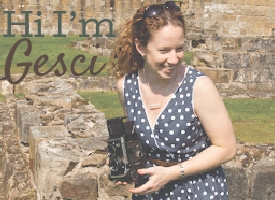Oświęcim is a small town in Poland which had a small Polish army barrack camp located just outside of it. This calm existence was destroyed in 1940, when the Nazis took over the army camp and renamed it in the German translation: Auschwitz.
The infamous sign at the main entrance to Auschwitz camp. This is actually a duplicate sign, as the original is being restored after having been stolen and damaged.
One of the original army buildings, near the main entrance.
A map of Europe showing the origins of prisoners of the camp. Please click on it, I feel certain you will be shocked at the distance.
The numbers.
Cans of Zyklon B found after the Nazi evacuation. Zyklon B was made up of cyanide based granules that reacted with the air to form a toxic gas. Experiments were carried out in September 1941 to determine how effective an exterminator this was and how long it took to kill a group of humans. 20 minutes was the average time of expiration.
A stove to warm the room where prisoners slept. So many humans were packed into each room that survivors described not being able to roll over without disturbing the entire row of people.
A prisoner-made drawing on the wall of the bathroom in the children's ward. There were several on the walls, believed to be have been drawn in an attempt to keep some sort of delight in the lives of the children.
The entrance to 10 Block.
The upper floor of each building was accessed by a side stairwell, walled off on the interior to prevent contact between the floors. This is Block 18A.
We toured Block 11, the building used for punishment of individual prisoners. These prisoners had acted in ways to threaten the Nazi power, either at the camp or politically. After going to "trial", with no legal representation and, if the prisoner did not speak German, no translation, the prisoners were punished. The punishment varied in severity, for example: the standing cell, where four men occupied a cell for the entire night with barely enough room to stand together and then continued to work the next day; a dark cell completely devoid of light or circulation, so the prisoner eventually suffocated; hanging by one's arms tied behind one's back; a firing squad. The gate shown above is the gate to the courtyard where this last punishment took place.
The courtyard between Blocks 10 and 11. You can see the windows of Block 10 are bricked up, so the prisoners could not watch the executions proceeding below them.
A recreation of the wall the condemned stood in front of for the firing squad.
A guard shack in the outer perimeter of the camp.
These signs existed around the edges of the camp.
The hospital block.
Unfortunately I can't remember the name of this device, as it was named for the SS guard who favored it. Prisoners were made to pull it along the roads in order to smooth out the gravel. If they seemed to be moving too fast, the guard, who was reported to be a large man, would sit on the bar in order to make it more difficult.
The guard shack near the entrance, where roll call was done. Prisoners were made to stand during roll call, no matter the weather, and if one was missing (those who died while working were carried there in order to be present) the entire camp was made to stand until the prisoner was found. This sometimes went on for hours, no matter the weather.
According to one survivor, a major deterrent for potential escapees was the knowledge of the punishment of his or her fellow prisoners.
A forbidden area between barracks.
The gallows. Rudolf Höss, the first camp commander, was hanged here after his trial.
Just off of the camp, only a matter of meters from the crematorium, was the house of the camp commander. Commander Höss's wife is reported to have said during his trial that their time living at Auschwitz was the happiest time of their lives. They lived at the camp for over three years with their five children.
The crematorium. These stretcher-like shelves pushed the bodies into the furnace, propelled on tracks.
The outside of the gas chamber and crematorium at Auschwitz.
One view of the camp, as seen from outside of the gas chamber.




































No comments:
Post a Comment
Thanks so much for stopping by! I can't wait to read your comment!